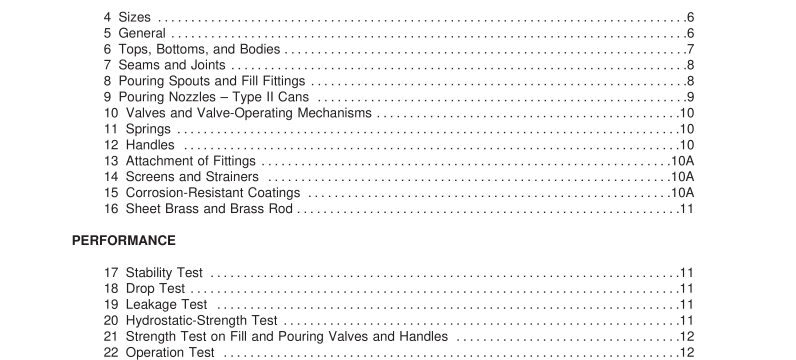UL 30-2009 pdf download – Metal Safety Cans.
5.8 A pouring spout shall be constructed to reduce the likelihood of spillage during pouring. 5.9 A Type II can shall incorporate a vent valve to permit the free discharge of liquid during a pouring operation. The vent valve shall open and close automatically and simultaneously with the opening and closing of the pouring valve. 5.1 0 An operating part of a can shall be constructed to reduce the likelihood of unintended opening of a valve. 5.1 1 Internal pressure in excess of 5 psig (34 kPa) shall be relieved by overcoming the spring pressure on the pouring- or filling-valve closure, or through an independent pressure-relief device. 5.1 2 Deleted November 30, 2000 6 Tops, Bottoms, and Bodies 6.1 The top, bottom, and body of a can shall be of either: a) Sheet brass, copper, or stainless steel, or b) Sheet steel provided with a corrosion-resistant coating that complies with the requirements in Corrosion-Resistant Coatings, Section 1 5. 6.2 The thickness of sheet metal shall at no point be less than the appropriate value specified in Table 6.1 . 6.3 The thickness of the metal is to be determined by five micrometer readings made at points spaced equally along the edge of the full piece as rolled. Measurements are to be made not less than 3/8 inch (9.5 mm) from a cut edge and not less than 3/4 inch (1 9.1 mm) from a mill edge. For drawn parts, the measurements are to be made after drawing. For painted parts, the thickness is to be measured under the paint. 6.4 The bottom surface of a can shall be recessed at least 1 /8 inch (3.2 mm) above the bottom perimeter of the sidewall to reduce the likelihood of puncturing or abrading the bottom.
7 Seams and Joints 7.1 Seams and joints in the top, body, and bottom of a can shall be welded, brazed, or lock-seamed. A lock-seamed joint shall be sweated with solder. Exception: A container employing unsoldered lock-seams that complies with the Drop Test, Section 1 8, need not have the lock seams sweated with solder. 7.2 A formed, circumferential top or bottom seam shall have strength equivalent to that of a double standing seam. A formed, vertical seam shall have strength equivalent to that of an offset hook seam. The metal overlap of a formed seam shall not be less than 1 /8 inch (3.2 mm) wide. 8 Pouring Spouts and Fill Fittings 8.1 A pouring spout or fill fitting shall be of corrosion-resistant metal or of ferrous metal that is provided with a corrosion-resistant coating that complies with the requirements in Corrosion-Resistant Coatings, Section 1 5. 8.2 A cast pouring spout or fill fitting shall not be less than 1 /8 inch (3.2 mm) thick. The wall thickness of tubing or other drawn material shall not be less than 0.05 inch (1 .3 mm). 8.3 The internal diameter of a fill fitting shall not be less than the appropriate value specified in Table 8.1 .
9 Pouring Nozzles – Type II Cans 9.1 A flexible or rigid nozzle of a Type II can shall be of corrosion-resistant metal, or ferrous metal provided with a corrosion-resistant coating that complies with the requirements in Corrosion-Resistant Coatings, Section 1 5. 9.2 The metal used in a flexible nozzle shall not be less than 0.01 5 inch (0.38 mm) thick. A rigid nozzle shall not be less than 0.035 inch (0.89 mm) thick. 9.2 revised September 1 , 1 999 9.3 The discharge end of a flexible nozzle shall be provided with a ferrule of corrosion-resistant metal. The ferrule shall be secured in place and shall enclose all sharp or projecting edges. 9.3.1 Deleted November 30, 2000 9.3.2 Deleted November 30, 2000 9.4 The valve or inlet end of a flexible nozzle shall be supported or reinforced by a closely wound external helical spring. The spring shall not be less than 3 inches (76.2 mm) long and shall be secured in place. 9.5 A nozzle shall be secured to a fitting constructed for attachment to the pouring spout. This fitting, in turn, shall be attached to the pouring spout by a method that provides a permanent connection that is free from leakage. Also, see Flexible Nozzle Test, Section 23. 9.6 A nozzle intended for use in automotive fueling applications for pouring directly into the fuel tank of a vehicle requiring unleaded gasoline shall have a maximum outside diameter of 0.86 inch (21 .8 mm). When a safety can is equipped with a nozzle having an outside diameter not greater than 0.86 inch (21 .8 mm), the safety can is not prohibited from being marked in accordance with paragraph 28.3.UL 30-2009 pdf download.
UL 30-2009 pdf download
